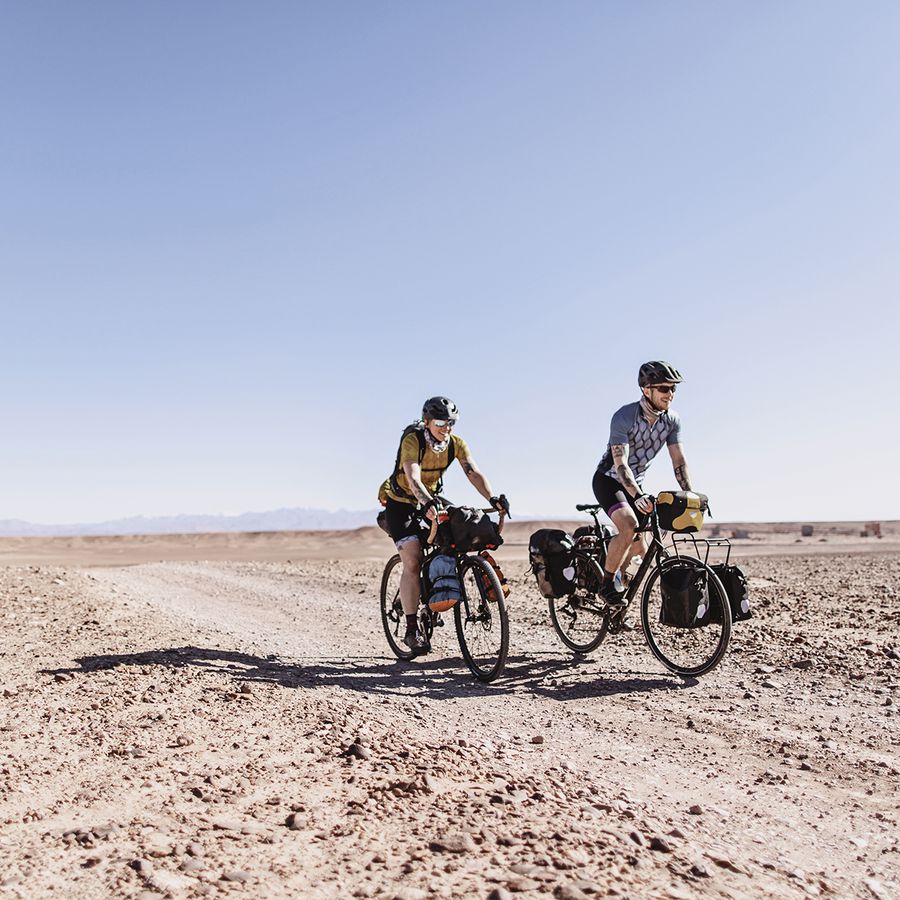
Hey, adventure lovers: If you’ve never tried bikepacking, you’ll want to clear a space on your calendar. Bikepacking, also called adventure biking, is the perfect combo of backpacking and cycling. Intrigued? Read on for beginner tips from expert bikepackers, plus the skills and gear you need to get started.
What is Bikepacking, Exactly?
Simply put, “bikepacking is loading up your bicycle with bags and heading out for an adventure,” says Lucas Winzenburg, editor of Bikepacking.com and founder of Bunyan Velo, a bikepacking magazine. Instead of riding on, say, city sidewalks or suburban paths — you head to more remote areas, which can include anything from dirt roads to mountain biking trails, depending on your style. Think of it as rolling along paths you’d typically hike, says Winzenburg.
Bikepacking is *slightly* different from bike touring — though they’re rooted in the same concepts. Both activities involve traveling by bike and carrying your gear, says bikepacking expert and blogger Josh Ibbett. People also use the terms interchangeably, though there are subtle differences that generally distinguish between the two. “Many differentiate bikepacking from traditional bicycle touring based on how you haul your stuff and the places you ride,” explains Winzenburg. Bike tourers typically carry lots of equipment in bulky bags attached to racks, he says, while backpackers go with lighter loads. Bikepackers also seek more isolated trails, while bike tourers mostly stick to paved roads. Some bikepackers choose to camp out while others rely on lodging during trips.
You don't need to get too caught up with the semantics, since there isn't one "right" way to bikepack, says Winzenburg. You can meander backroads between vineyards in Italy (swoon) or take on the steep mountain tracks in the Rockies. Or you can do a quick overnight trip to a local campground. And guess what? It all counts. (
Katadyn Hiker Microfilter Water Filter
Adventure Medical Kits Ultralight Watertight .5 Medical First Aid Kit
Cycling GPS Unit or App
If you’re venturing into unfamiliar terrain, you’ll need a bike-friendly GPS. A cycling GPS provides route directions, along with data like elevation and speed. Ibbett uses Wahoo GPS units, which he says are reliable and user-friendly. Try: Wahoo ELEMNT Bolt GPS Bike Computer (Buy It, $230, amazon.com). You can also technically use your smartphone, but you’ll have to closely monitor your battery life. (To do this, turn on “airplane mode” and limit overall phone use.) Even without service, your phone’s GPS should still work as long as you pre-download the maps for the route. Many bikepackers on the web love Gaia GPS, an app that lets you navigate the backcountry sans service.
If you're concerned about your smartphone surviving the trip, a cycling GPS may be the way to go. In either case, bring a backup battery and familiarize yourself with your navigation system before heading out.
How to Start Bikepacking
So, you've got the bike, gear, and lust for adventure. Great! Not so fast, though — you'll want to make a plan before setting out.
Start by picking a route. You can find routes created by adventurers across the globe on bikepacking websites. For example, Bikepacking.com has routes covering about 50 countries and totaling 85,000 miles complete with photos and tips, says Winzenburg. The routes include everything from short overnighters to multi-month tracks across countries, so there’s something for everyone. Rockwell also recommends Adventure Cycling Association for first-time bikepackers. Here, you’ll find resources like routes, maps, and organized guided trips.
You can even DIY a route with online tools like Ride with GPS and Komoot. Both options “allow you to draw your own routes or see what others are doing around you,” says Winzenburg. Either way, “plan a route where [you’ll find] a water source at the end of the day, and a convenience store or restaurant after more than two days of travel,” says Rockwell.
Once you've chosen a route, test ride your bike before your actual trip, says Kershaw. Load it up with the gear you plan to bring and ride on a trail that's similar to your planned adventure. This is key for figuring out if your setup needs to be adjusted. You'll thank yourself later.
During a bikepacking trip, most folks can expect to ride 10 to 30 miles a day to start — but the total distance depends on many factors, says Kershaw. (For example, the terrain, weather, and your fitness level all play a role.) Start with shorter rides and let yourself acclimate to the bike and gear; you can plan longer trips from there. (
When it’s time to turn in for the night, most bikepackers camp out. However, deciding where to sleep is super subjective, notes Kershaw. He’s all about sleeping outside whenever he can, but “there’s no shame in finding a great motel, hostel, or inn — particularly after a long stretch of camping or surviving terrible weather,” he says. Ultimately, it’s best to do what makes you feel most comfortable and safe, especially if you’re riding alone.
If you’re new to bikepacking, planning a trip can be pretty intimidating. Try bikepacking with someone who’s done it before (or joining a guided trip), which will make the experience less stressful — and more fun. Who knows, you might just discover a new favorite way to explore the great outdoors.






































